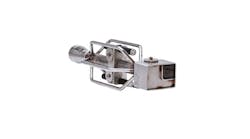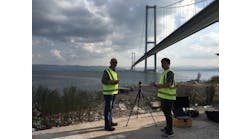Rapid advances in technology are dramatically changing the way bridge surveyors and engineers perform their tasks and conduct their business. The most recent technological innovation is the use of high-definition scanners that combine digital photography and laser measurement to develop a three-dimensional image of the objects being surveyed.
High-definition scanning (HDS) uses a laser scanner to reproduce exactly what it sees in three dimensions. The result appears to be a digital photograph, but it is actually a reproduction of hundreds of data points closely packed together, forming what is referred to as a point cloud. This cloud of data is visually enhanced with digital photography for easier viewing. The models that are created three dimensionally can be rotated a full 360° for viewing or measuring and then imported to CAD software to prepare maps.
Using HDS, an entire bridge can be scanned from various vantage points, detailing the piers, bearings, stringers and vertical clearances. Thus one image can provide detailed views from any perspective, making it possible for a client to view any segment of the bridge with the click of a mouse.
Everything in the picture
HDS technology offers many benefits. Entire structures can be scanned and reproduced. Bridge piers and stringers can be viewed, rotated and measured. Traditionally, surveyors are asked to obtain many measurements on bridge decks and below. Bridge seat elevations, pedestal elevations, abutments, skew angles and vertical clearances are commonly required. In many cases, the location of these areas requires access by lift trucks, cherry pickers or boats.
The use of the HDS scanner is not only more effective, it is far more thorough as it captures more data. It also provides an extra margin of safety because vertical clearances to roadway surfaces can be obtained without closing lanes. The HDS scanner is an ideal as-built tool. Many older structures have poor or non-existent as-constructed drawings. With HDS, bridges and other structures can be completely measured.
Eyeing a touch down
A current application of HDS technology is a pedestrian bridge replacement project in upper Manhattan, spanning the Metro North Railroad in New York City. The existing bridge is an extension of a tunnel that is 25 ft beneath the street. The bridge extends over an active commuter railroad and touches down under an elevated highway. It is a dangerous touch-down point requiring pedestrians to cross the exit and entrance ramps to the highway.
The proposed bridge will carry pedestrians from the high street over the railroad and the elevated highway, touching down on the bank of the Hudson River. The scanner made it possible to measure the existing bridge and obtain elevations of the railroad track and vertical clearances to the highway. The face of the existing retaining wall supporting the street above also was scanned.
From above, it was possible to scan the road surface of the highway and the topography of the high street. Obtaining field measurements of these areas using conventional instruments would have taken a full week; using the scanner, the work was completed in two days. In addition to saving time, HDS enabled engineers and surveyors to obtain cross sections of the highway without closing lanes and to measure top-of-rail elevations without entering the railroad area.
Revolutionary scanning
Under contract with the New Jersey Department of Transportation (NJDOT) Division of Project Planning & Development and Feasibility Assessment, Vollmer Associates completed the rehabilitation and replacement of the South Broad Street bridge over the Assunpink Creek in Trenton, N.J. The objective was to develop a project alternative that would eliminate existing structural and geometric inadequacies while minimizing inconvenience during construction.
The original single-span, stone-masonry arch structure, built in 1843, was the oldest bridge in Trenton. The project is located at the core of the historic city and is listed as eligible on the National Register. The site was home to Trenton’s first major industry, the Mahlon Stacy Grist Mill, the scene of the second Battle of Trenton during the Revolutionary War and the point of General Washington’s ceremonial crossing of the Assunpink Creek through the triumphal arch en route to his presidential inauguration in 1789.
During the concept-development phase, in-depth structural inspection, geophysical subsurface investigation, materials testing and structural analysis were performed to accurately determine the as-built and existing capacity of the stone-masonry arch bridge.
The partial bridge replacement with a downstream realignment was selected as the initially preferred alternative. In this design, the existing exterior arches would be removed and the original center arch would be widened to the downstream side with a modern structure. The new structure would carry all vehicular traffic and the area above the original arch would be closed to vehicular traffic and used as a pedestrian walkway.
The selection of this option satisfies the aim of the project by accommodating modern design loads and vehicles and eliminating the structurally deficient element while also preserving the historical integrity of the original center arch. In addition, this option provides an opportunity to view the original center arch and improves pedestrian connectivity with Mill Hill Park.
Due to the bridge’s age, there were no as-built drawings on file. Through the use of scanning technology, the geometry of the arch and the patterns of the stone masonry were accurately reproduced. By positioning the instrument at various locations, different views of the structure were scanned and meshed together to form a seamless three-dimensional reproduction of the structure.
HDS has the potential to dramatically change the manner in which bridges are scanned. Its use will increase efficiency, save considerable time during the course of a project and result in significant savi

